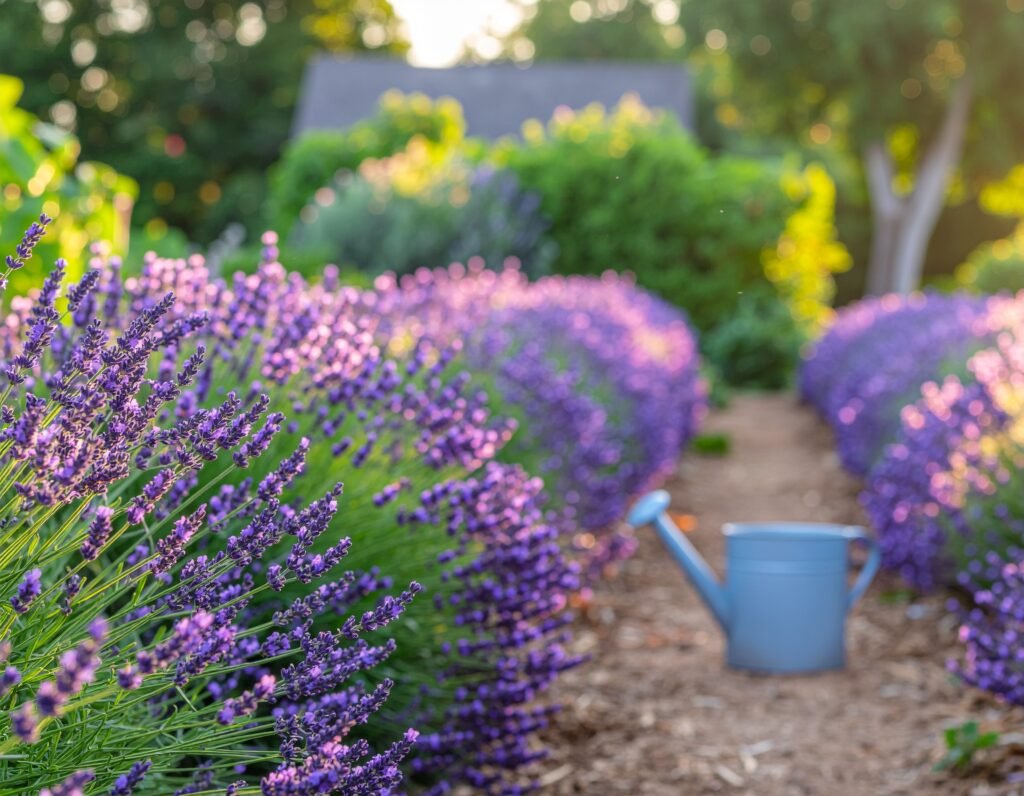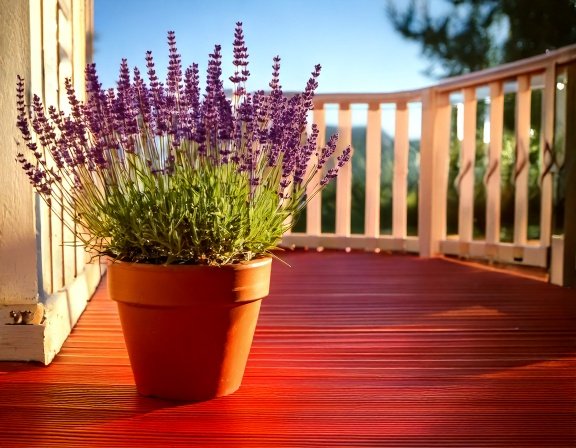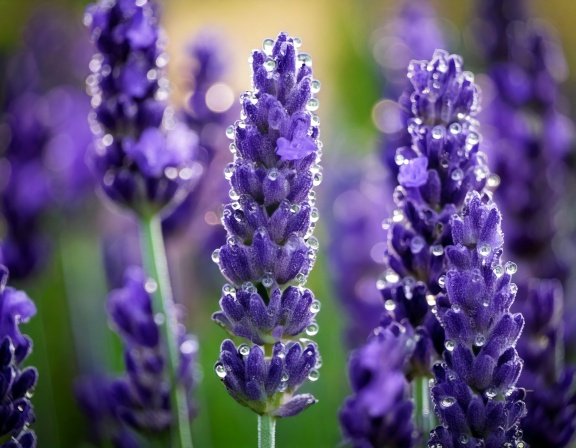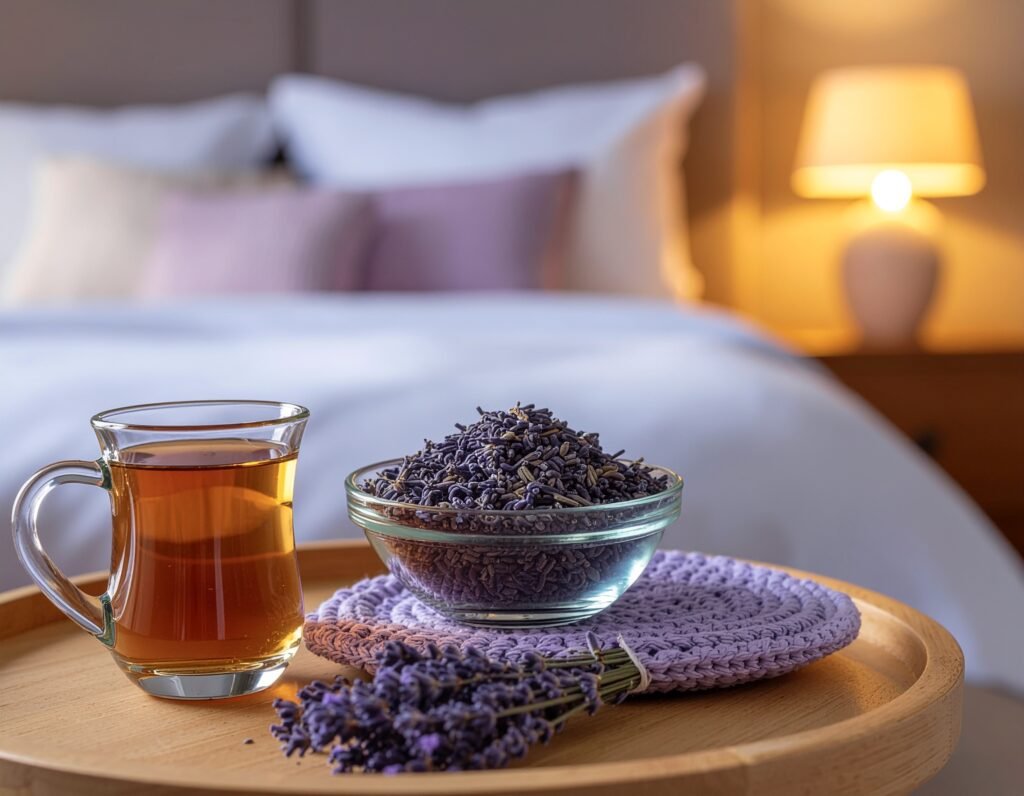Lavender: Planting, Growing, and Using for Calm and Sleep
A gentle, garden-first approach to deeper sleep and less stress—how to plant and care for lavender, harvest it right, and use it safely in teas, baths, sprays, and sachets.
A simple 10–20 minute evening routine—lavender tea & bath pairings, lights-down checklist, and a quick breathwork card.
Sleep Wind-Down Kit
Lavender (Lavandula angustifolia) isn’t just a beautifully fragrant herb—it’s a beloved natural remedy famous for its calming and sleep-promoting properties. Growing lavender in your garden means having easy access to its soothing scent, relaxing teas, and restful herbal pillows. Discover how simple it is to cultivate this stress-relieving plant right at home.
Fun Fact: Lavender was widely used in ancient Rome for baths—the word “lavender” derives from the Latin lavare, “to wash.”
Why lavender calms (and safety)
Lavender’s distinctive aroma is rich in linalool and linalyl acetate, fragrant molecules associated with relaxation and lower perceived stress. When paired with good sleep hygiene—dim lights, consistent schedule, screens off—lavender can help many people unwind before bed.
Safety first: Culinary and tea amounts are generally well tolerated. Essential oils should not be ingested; always dilute for topical use. If pregnant, nursing, using on children, or taking sedatives/SSRIs, consult your clinician.
Mood Balance & Safety Guide
Know when to use calming herbs (lavender, chamomile, lemon balm), who should be cautious, and how to build a safe bedtime routine.
Send me the guideHow to Plant Lavender Successfully
Lavender isn’t just a fragrant flower—it’s a healing herb, a pollinator’s paradise, and a timeless garden favorite. Known for its calming scent and antibacterial properties, lavender thrives when planted with care and an understanding of its natural habitat. Whether you’re growing it to harvest oils, make herbal sachets, or simply enjoy its soothing color in your garden, success begins with proper planting.
1. Choose the Right Location
Lavender loves the sun. Select a spot that receives at least 6–8 hours of direct sunlight daily. The plant originates from Mediterranean regions, so it prefers warm, dry conditions rather than humidity or shade.
Tip: Avoid areas where water collects after rain—lavender roots dislike standing moisture and can quickly rot.
2. Prepare Well-Draining Soil
The most common reason lavender fails to thrive is poor drainage. It does best in light, sandy, or loamy soil with a slightly alkaline pH (6.5–7.5). If your soil is heavy or clay-based, mix in sand, gravel, or perlite to improve aeration.
Optional: Add a handful of crushed eggshells or garden lime to slightly raise alkalinity and mimic lavender’s native soil conditions.
3. Planting Time and Depth
- Plant lavender in spring or early summer after the danger of frost has passed.
- Space each plant about 18–24 inches apart to allow air circulation.
- Dig a hole just deep enough for the root ball.
- Place the plant so the crown sits level with the soil surface.
- Backfill gently and pat down the soil without compacting it.
Water lightly after planting—lavender prefers to stay on the drier side once established.
Variation 1: Pain/Ailment Relief AngleSleep Lean: Restore Restful Sleep, Reset Metabolism
- Targets hidden causes of stubborn weight—especially poor sleep & blue light
- Supports deep N-REM rest, so your body repairs and burns fat naturally
- Relief for restless nights, stubborn weight, and stress-related sleep issues
4. Mulching and Watering
Use light-colored gravel or coarse sand mulch instead of bark mulch to reflect sunlight and keep moisture balanced. Water young plants once or twice weekly during their first growing season, then reduce frequency as they mature.
Reminder: Overwatering is a common mistake—when in doubt, let it dry out.
5. Companion Plants & Garden Design
Lavender pairs beautifully with other drought-tolerant herbs like rosemary, thyme, and sage. It also enhances pollinator gardens and deters pests naturally.
Create a Mediterranean-style border or rock garden where it can shine in full sun and free-draining soil.
6. Post-Planting Care
Once your lavender is settled, prune it lightly after flowering to maintain shape and encourage new growth. Avoid cutting into woody stems. With proper care, a single lavender plant can flourish for up to 10 years or more.
Plant Type: Perennial herb/shrub
Zones: USDA Zones 5–9 (varies slightly by variety)
Sunlight: Full sun (at least 6–8 hours/day)
Soil: Well-draining, sandy or gravelly soil—lavender hates wet feet!
Propagation: From seeds (slower), nursery plants, or cuttings (fastest)
Gardener’s Tip: Mix coarse sand or fine gravel into the soil to improve drainage—lavender thrives in dry conditions.


Caring for Your Lavender Plants
Yu Sleep: Nature’s Solution for Sleep & Recovery
- Features Red Tart Cherry, Lemon Balm, L-Theanine, GABA, Melatonin, and Magnesium Glycinate
- Zero synthetic additives—every ingredient from a natural source
- Nano-enhanced for rapid absorption and gentle nightly support
Once your lavender is in the ground, the next step is consistent yet gentle care. Lavender is a resilient herb, but it rewards attentive growers with stronger stems, fuller blooms, and a longer lifespan. The key to successful care lies in balance — not too much water, not too little pruning, and plenty of sunshine. Here’s how to keep your lavender thriving season after season.
1. Watering Routine
Lavender prefers dry roots. After the first few weeks of establishment, allow the soil to dry out between waterings. Overwatering leads to root rot, especially in humid climates. A good rule of thumb: water deeply but infrequently.
- Young plants: Once or twice a week during the first growing season.
- Established plants: Every two to three weeks, or when the top inch of soil is completely dry.
Tip: Always water at the base to keep leaves dry and prevent fungal issues.
2. Fertilizing and Feeding
Lavender doesn’t need heavy feeding. Too much fertilizer can make the plant produce more leaves and fewer flowers. Instead, use a balanced organic compost or a slow-release fertilizer once in early spring.
Optional boost: A light sprinkle of bone meal or wood ash can enhance bloom quality and fragrance without overstimulating foliage growth.
3. Pruning for Health and Shape
Regular pruning keeps lavender bushy, prevents woody stems, and encourages new growth. Prune lightly after flowering and more deeply in early spring to shape the plant before active growth begins.
- Use sharp, clean shears to avoid tearing stems.
- Trim about one-third of the top growth, avoiding cuts into old woody stems.
- Shape into a neat mound to allow even sunlight exposure.
Reminder: Avoid heavy pruning in late fall — it can expose the plant to frost damage.
Sleep Lean: Plant-Based Support for Rest & Renewal
- Formulated from Valerian, Humulus lupulus, Griffonia (5-HTP), Spirulina Blue, Black Cohosh & more
- No artificial fillers—just pure botanicals and functional nutrients
- Helps rebalance your sleep and metabolism gently, the natural way
4. Managing Pests and Diseases
Lavender’s natural oils repel most pests, but occasional issues can arise. Watch for spittlebugs (small foamy clumps on stems) or root rot in poorly drained areas.
- Remove affected leaves and improve air circulation around the plant.
- Avoid overhead watering to prevent fungal infections.
- If root rot appears, dig up and replant in raised beds or containers with better drainage.
5. Seasonal Care
Lavender behaves differently with each season. In colder climates, it may need a bit of extra protection, while in warmer regions it remains evergreen.
- Spring: Prune lightly and feed with compost or organic fertilizer.
- Summer: Harvest blooms regularly to encourage new flowers.
- Fall: Remove faded blooms but avoid heavy pruning before frost.
- Winter: In cold zones, add a thin layer of straw or mulch to protect roots from freezing.
6. Harvesting and Drying
To make the most of your lavender harvest, cut flower stems when buds are just opening for peak fragrance and oil content. Gather small bundles, tie them with string, and hang them upside down in a cool, dry, shaded area.
Properly dried lavender can last up to a year and is perfect for homemade sachets, essential oils, teas, or herbal skincare blends.
| Watering | Minimal once established; drought-tolerant |
| Feeding | Rarely needed—minimal compost or balanced fertilizer yearly |
| Maintenance | Regular pruning encourages growth and maintains shape |
| Pests/Disease | Usually resistant; watch for root rot (ensure good drainage) |
Gardener’s Tip: After flowering, prune lavender back lightly—about 1/3 of growth—to encourage vigorous blooms the following season.
Active Ingredient: Linalool and linalyl acetate give lavender its calming, anti-anxiety, and sedative properties.
Harvesting & Storing Lavender
Harvest flowers just as blooms open fully for best fragrance. Cut stems mid-morning after dew evaporates, avoiding midday heat. Bundle and hang upside-down in a dry, dark area until fully dry (about 2 weeks). Store dried lavender buds in airtight jars away from sunlight and moisture.
Gardener’s Tip: For peak aroma, harvest during early bloom stages rather than waiting for full maturity.
Fun Fact: In medieval Europe, lavender was placed under pillows or sewn into nightcaps to improve sleep and ward off nightmares.


Build Your Bedtime Routine
Short disclosure: Some links may be affiliate/sponsored. If you purchase, we may earn a commission at no extra cost to you.
- Java Burn or Tea Burn — morning metabolism support to complement your night routine. Learn More About Java Burn · Read About Tea Burn
- CBD Turmeric RELIEF — for body comfort and daily recovery. Discover CBD Turmeric Relief
Home Uses of Lavender for Calm & Sleep
Beyond its beauty in the garden, lavender’s greatest gift lies in its calming aroma and soothing properties. For centuries, it has been used in homes and monasteries to ease stress, quiet the mind, and promote restful sleep. Today, you can bring that same peace into your daily life with simple lavender-based rituals and remedies.
1. Lavender Sachets and Pillow Inserts
Placing dried lavender near your bed can naturally calm the nervous system and reduce restlessness. The scent of lavender encourages relaxation by lowering heart rate and easing tension.
- Fill small cotton sachets or fabric pouches with dried lavender buds.
- Keep one under your pillow, or in your linen drawer to scent your sheets.
- Replace or refresh sachets every few months for best results.
Tip: Add a few drops of lavender essential oil to intensify the aroma before bedtime.
2. Lavender-Infused Bath or Foot Soak
A warm bath infused with lavender can relieve physical fatigue and promote deeper sleep. The essential oils are released by the heat, surrounding your senses with calm.
- Add 8–10 drops of lavender essential oil or a handful of dried buds to warm bath water.
- For a simpler ritual, soak your feet for 15 minutes before bed.
- Combine with Epsom salt for added muscle relaxation and detox support.
3. Calming Room or Linen Spray
Homemade lavender mist is a quick and effective way to freshen up your bedroom, meditation space, or work area. It helps purify the air while creating a relaxing environment.
- Mix 1 cup distilled water, 2 tablespoons witch hazel, and 10–15 drops lavender essential oil in a spray bottle.
- Shake before each use and mist your pillow, curtains, or yoga mat.
Optional: Add chamomile or clary sage oil for an extra layer of relaxation.
4. Lavender Tea for Evening Wind-Down
Drinking lavender tea before bed supports digestion and encourages restful sleep. It also soothes mild anxiety and helps the body unwind after a long day.
- Steep 1 teaspoon of dried lavender flowers in hot water for 5–7 minutes.
- Sweeten with a touch of honey or pair with chamomile for a stronger calming blend.
5. Aromatherapy and Essential Oils
Lavender essential oil can be diffused or applied topically (when diluted) to relieve stress and aid sleep. Inhaling the scent signals the brain to relax and can improve sleep quality.
- Diffuse 4–6 drops of lavender oil in your bedroom 30 minutes before sleep.
- For topical use, mix a few drops with a carrier oil like jojoba or sweet almond oil and apply to your wrists or temples.
- Use consistently at the same time each evening to train your body into a restful rhythm.
6. Integrating Lavender into Daily Rituals
Use lavender as part of your nightly wind-down routine — light a lavender candle, sip herbal tea, or pray or meditate with a few drops of oil on your palms. These small rituals cultivate peace and signal your body that it’s time to rest.
Whether in sachets, sprays, teas, or oils, lavender is nature’s gentle reminder to slow down and breathe deeply — a fragrant path to calm and restorative sleep.
- Lavender Tea: Reduces stress, promotes relaxation and restful sleep
- Lavender Pillow & Sachets: Helps soothe insomnia and anxiety naturally
- Bath & Foot Soak: Calms nervous tension, eases headaches, encourages deep sleep
- Aromatherapy & Oil Diffuser: Gentle sedative effect, improves mood and emotional well-being
DIY Sleep Recipes (Kitchen-Simple)
- Bedtime Tea: 1 tsp dried lavender + 1 tsp chamomile in 8–10 oz hot water, 5–7 minutes. Optional: lemon peel or honey.
- Calming Bath Soak: 1 cup Epsom salt + 1/2 cup baking soda + 2 tbsp dried lavender; optionally 3–5 drops essential oil diluted in a spoon of carrier oil.
- Linen Spray: 1/2 cup distilled water + 1/2 cup witch hazel + 10–15 drops lavender essential oil; mist pillows 10–15 minutes before bed.
- Pillow Sachet: Fill a muslin pouch with 2–3 tbsp dried florets; squeeze to refresh aroma.
This herbal recipe is shared for educational purposes only, based on traditional use and available sources. It is not medical advice. Please consult your healthcare provider before use, especially if pregnant, nursing, or on medication.
Active Ingredient Highlight: Studies associate inhaled lavender aroma with improved sleep quality and reduced anxiety—use alongside consistent sleep habits.
Lavender is a gateway to restful nights and calmer days. With this easy-to-grow herb, you can naturally nurture a relaxing sanctuary at home.
Ready to sleep deeper, naturally?
Get calming herbal guides, bedtime rituals, and easy garden-to-remedy projects.
Subscribe nowFinish Your Bedtime Routine
Download the Sleep Wind-Down Kit and the Mood Balance & Safety Guide—make lavender a reliable nightly habit.
Send me the bundleSmart Pairings for Calm & Nightly Reset
- CBD Turmeric RELIEF — daily comfort and recovery, plant-powered. Learn More About Relief
- Quietum Plus — ear/noise wellness when stress spikes. Check QuietumPlus Details
- Sugar Defender — for readers managing evening sweet-tooth swings. Read About Sugar Defender
- Green Tea Energy → Java Burn / Tea Burn (morning stack that won’t clash with lavender nights).
Disclosure: We may earn a commission if you purchase through our links—at no extra cost to you. We only recommend options aligned with our editorial standards.